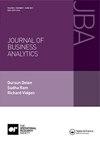Analysis of employee perception of employer brand: a comparative study across business cycles using structural topic modelling
IF 1.6
Q3 COMPUTER SCIENCE, INFORMATION SYSTEMS
引用次数: 1
Abstract
ABSTRACT Employer branding is an important measure to attract prospective employees and to motivate, engage, and retain their current employees. Employer branding is instrumental for the employer to position the organisation in the minds of current and potential employees by using a combination of economic, psychological, and functional benefits. In the current research the authors implement a set of natural language processing techniques (structural topic modelling) on the employee reviews posted on Glassdoor.com (an online platform where the employees can post reviews about their current and previous employers). The study has thematically structured the 35,075 reviews from 8 Information Technology companies, spanning 5 years from 2015 to 2019. The study compares the employer branding parameters and has identified the prominent dimensions across the expansionary (2015–2017) and contractionary (2017–2019) phases of business cycles. A significant difference in topical proportions were found across the business cycles, suggesting different priorities for different dimensions of the employer brand during expansionary and contractionary phases. The findings would serve as guidance for HR managers to understand the trends in the employee perceptions in the context of changing macro-environment situations and accordingly recalibrate their existing strategies for talent attraction and retention员工对雇主品牌的认知分析:使用结构主题模型的跨商业周期比较研究
雇主品牌是吸引潜在员工和激励、吸引和留住现有员工的重要措施。雇主品牌是雇主通过结合经济、心理和功能利益,在现有和潜在员工心目中定位组织的工具。在目前的研究中,作者对发布在Glassdoor.com(一个在线平台,员工可以在其中发布对现任和前任雇主的评论)上的员工评论实施了一套自然语言处理技术(结构主题建模)。该研究对8家信息技术公司的35075份评论进行了主题结构化,时间跨度为2015年至2019年的5年。该研究比较了雇主品牌参数,并确定了商业周期扩张(2015-2017)和收缩(2017-2019)阶段的突出维度。在整个商业周期中,主题比例存在显著差异,这表明在扩张和收缩阶段,雇主品牌的不同维度有不同的优先级。研究结果将指导人力资源管理者在不断变化的宏观环境下了解员工感知的趋势,并据此重新调整现有的人才吸引和保留策略
本文章由计算机程序翻译,如有差异,请以英文原文为准。
求助全文
约1分钟内获得全文
求助全文
来源期刊

Journal of Business Analytics
Business, Management and Accounting-Management Information Systems
CiteScore
2.50
自引率
0.00%
发文量
13
 求助内容:
求助内容: 应助结果提醒方式:
应助结果提醒方式:


